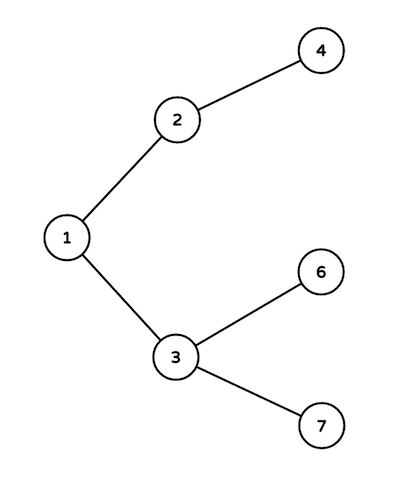C. Lorenzo Von Matterhorn
Barney lives in NYC. NYC has infinite number of intersections numbered with positive integers starting from 1. There exists abidirectional road between intersections i and 2i and another road between i and 2i + 1 for every positive integer i. You can clearly see that there exists a unique shortest path between any two intersections.

Initially anyone can pass any road for free. But since SlapsGiving is ahead of us, there will q consecutive events happen soon. There are two types of events:
1. Government makes a new rule. A rule can be denoted by integers v, u and w. As the result of this action, the passing fee of all roads on the shortest path from u to v increases by w dollars.
2. Barney starts moving from some intersection v and goes to intersection u where there's a girl he wants to cuddle (using his fake name Lorenzo Von Matterhorn). He always uses the shortest path (visiting minimum number of intersections or roads) between two intersections.
Government needs your calculations. For each time Barney goes to cuddle a girl, you need to tell the government how much money he should pay (sum of passing fee of all roads he passes).
Input
The first line of input contains a single integer q (1 ≤ q ≤ 1 000).
The next q lines contain the information about the events in chronological order. Each event is described in form 1 v u w if it's an event when government makes a new rule about increasing the passing fee of all roads on the shortest path from u to v by w dollars, or in form 2v u if it's an event when Barnie goes to cuddle from the intersection v to the intersection u.
1 ≤ v, u ≤ 1018, v ≠ u, 1 ≤ w ≤ 109 states for every description line.
Output
For each event of second type print the sum of passing fee of all roads Barney passes in this event, in one line. Print the answers in chronological order of corresponding events.
Example
input
Copy
7
1 3 4 30
1 4 1 2
1 3 6 8
2 4 3
1 6 1 40
2 3 7
2 2 4
output
Copy
94
0
32
Note
In the example testcase:
Here are the intersections used:

- Intersections on the path are 3, 1, 2 and 4.
- Intersections on the path are 4, 2 and 1.
- Intersections on the path are only 3 and 6.
- Intersections on the path are 4, 2, 1 and 3. Passing fee of roads on the path are 32, 32 and 30 in order. So answer equals to 32 + 32 + 30 = 94.
- Intersections on the path are 6, 3 and 1.
- Intersections on the path are 3 and 7. Passing fee of the road between them is 0.
- Intersections on the path are 2 and 4. Passing fee of the road between them is 32 (increased by 30 in the first event and by 2 in the second).
题意:一颗完全二叉树,起初任意两点之间都没有权重,然后每次在两点之间的每一条边添加一个权重(可以累加)。每次询问从某一点到另外一个点需要多少代价。
由于二叉树良好的特性,我们每次将当前点值除而即为父节点,而两点之间的路线固定,为不断除以二直到相等为止。这里没词将较大值除以二,直到相等。储存边权采用map,下标为这一条边靠下的那个节点。
#include<bits/stdc++.h>
#define ll long long
#define inf 0x3f3f3f3f
#define in(a) scanf("%I64d",&a)
#define for(i,a,b) for(int i=a;i<=b;i++)
#define pii pair<ll,ll>
using namespace std;
map<ll,ll> s;
ll t;
void add(ll x,ll y,ll z)
{
if(x==y) return;
else
{
if(x>y) swap(x,y);
if(s.count(y)) s[y]+=z;
else s[y]=z;
y>>=1;
add(x,y,z);
}
}
void enqu(ll x,ll y)
{
if(x==y) return;
else
{
if(x>y) swap(x,y);
if(s.count(y)) t+=s[y];
y>>=1;
enqu(x,y);
}
}
int main()
{
ll q,m,n,x;
in(q);
while(q--)
{
in(m);
if(m==1)
{
in(m);in(n);in(x);
add(m,n,x);
}
else
{
in(m);in(n);
t=0;
enqu(m,n);
printf("%I64d\n",t);
}
}
return 0;
}
不得不说,以下俄罗斯的代码真的挺优雅
#include <iostream>
#include <map>
using namespace std;
map<long long, long long> mp;
int main() {
ios_base::sync_with_stdio(false);
cin.tie(0);
int q;
cin >> q;
for(int qq = 0; qq < q; qq++) {
int t;
cin >> t;
if(t == 1) {
long long v, u, w;
cin >> v >> u >> w;
while(v != u) {
if(v < u)
swap(v, u);
mp[v] += w;
v /= 2;
}
}
else {
long long v, u;
cin >> v >> u;
long long ans = 0;
while(v != u) {
if(v < u)
swap(v, u);
ans += mp[v];
v /= 2;
}
cout << ans << '\n';
}
}
return 0;
}